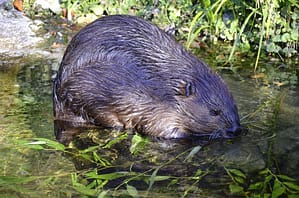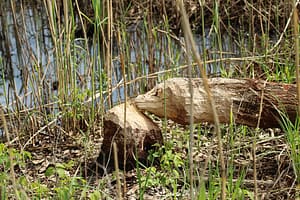Frankly, my dear, they just didn’t give a dam…

During the Covid Pandemic we can be forgiven for experiencing a drop in productivity.
However, when representatives of Exmoor’s beaver colony recently blamed ‘extinction’ for four centuries of no effort, it sparked outrage across the country.
“I don’t think you can use absence as an excuse these days.” exclaimed one disgruntled local. “The wife and I had two weeks in Benidorm last year and I hosted a webinar from my lilo every day!”
Likewise, others moved to dismiss the species altogether: “I always preferred squirrels anyway, they’re always beavering away with their nuts.”
A fascinating insight, I’m sure you’ll agree, and perhaps evidence as to why the UK hasn’t seen more jackpot winners on Who Wants To Be A Millionaire. Even so, the beavers’ claim of extinction does have substance.
Back From The Dead… Sort Of

Yes, like so many others, beavers fell foul of humanity’s appetite for fur, meat and castoreum oil. Hence, from the 16th century onwards, the tree-gnawing rodents were extinct in the UK.
That was until 2009 when The Scottish Beaver Trial saw a population of 11 Eurasian Beavers reintroduced in Knapdale, Argyll. Since then, the buck-toothed rodents haven’t looked back (they can’t, they have no neck… ok I may have made that up).
Following a successful stint with the Scots, further trials saw Beavers reintroduced in Devon (2011), Cornwall (2017) and finally Exmoor (2020). The latter, of course, being the source of this particular good news story. Bea-vrilliant stuff (anyone? No?)!
Why Is This Good News?

Well, to bea-very frank (too far?), the beaver’s return is good news because the UK’s (and much of mainland Europe’s) wetland flora and fauna evolved to the tune of their tree-felling teeth.
Hence, much of Europe’s wetlands are set to thrive amidst the beaver’s comeback. What’s more, so too are we.
How Will We Benefit From The Beaver?
Beavers are nature’s answer to gamekeepers, tirelessly engineering their surroundings and restoring wetland areas old and new. The transformation of these semi-aquatic environments not only reduces risk of flood but maximises biodiversity and enhances an area’s ability to store carbon.
On top of that, Europe’s largest rodents fell trees sustainably – let’s hope we’re taking notes!

This selective forest management stimulates new growth and provides smaller and younger plants access sunlight hitherto gobbled up by the thick forest canopy.
However, perhaps the beaver’s most impressive quality is their ability to improve water quality. That’s right, beaver dams can help filter pollutants like nitrate and phosphate out of the water!
So in summary, that’s: cleaner water, healthier biodiversity, carbon capture and their name is a euphemism. What a fantastic addition to our (hopefully) regrowing wilderness! Now tell me you don’t love a beaver!
What to find out more? Here’s a link to Natural England’s 2009 report on the matter.



